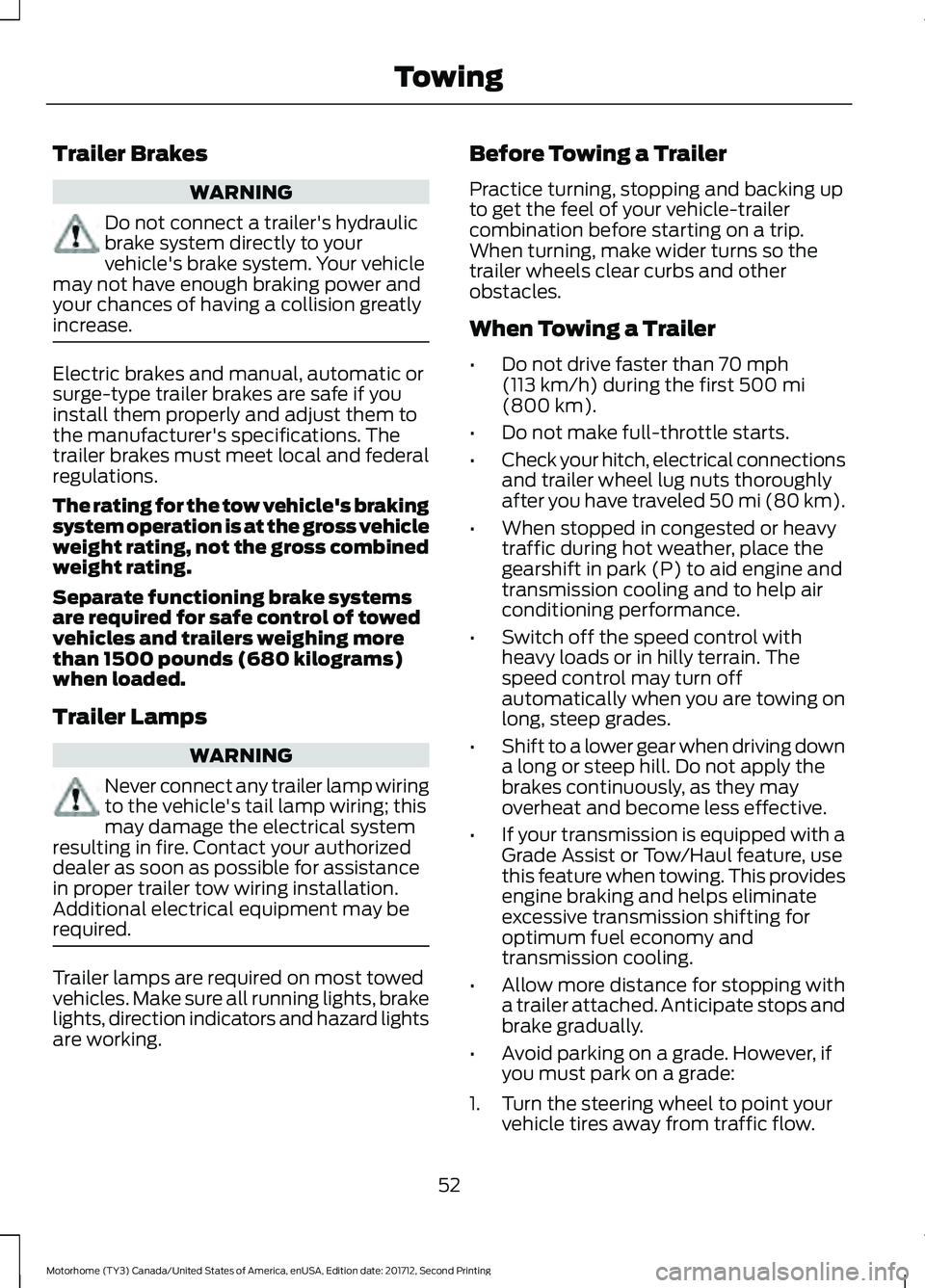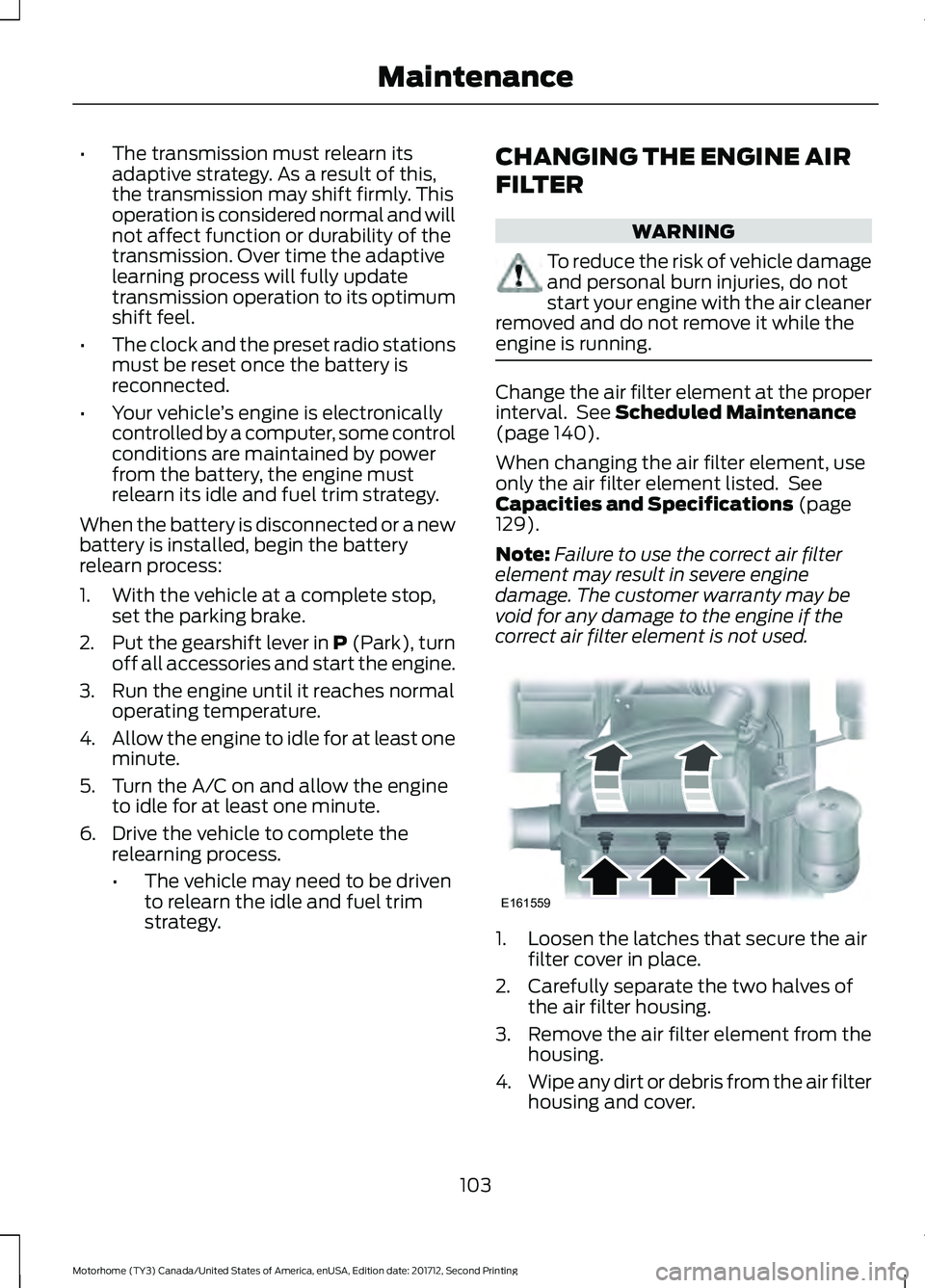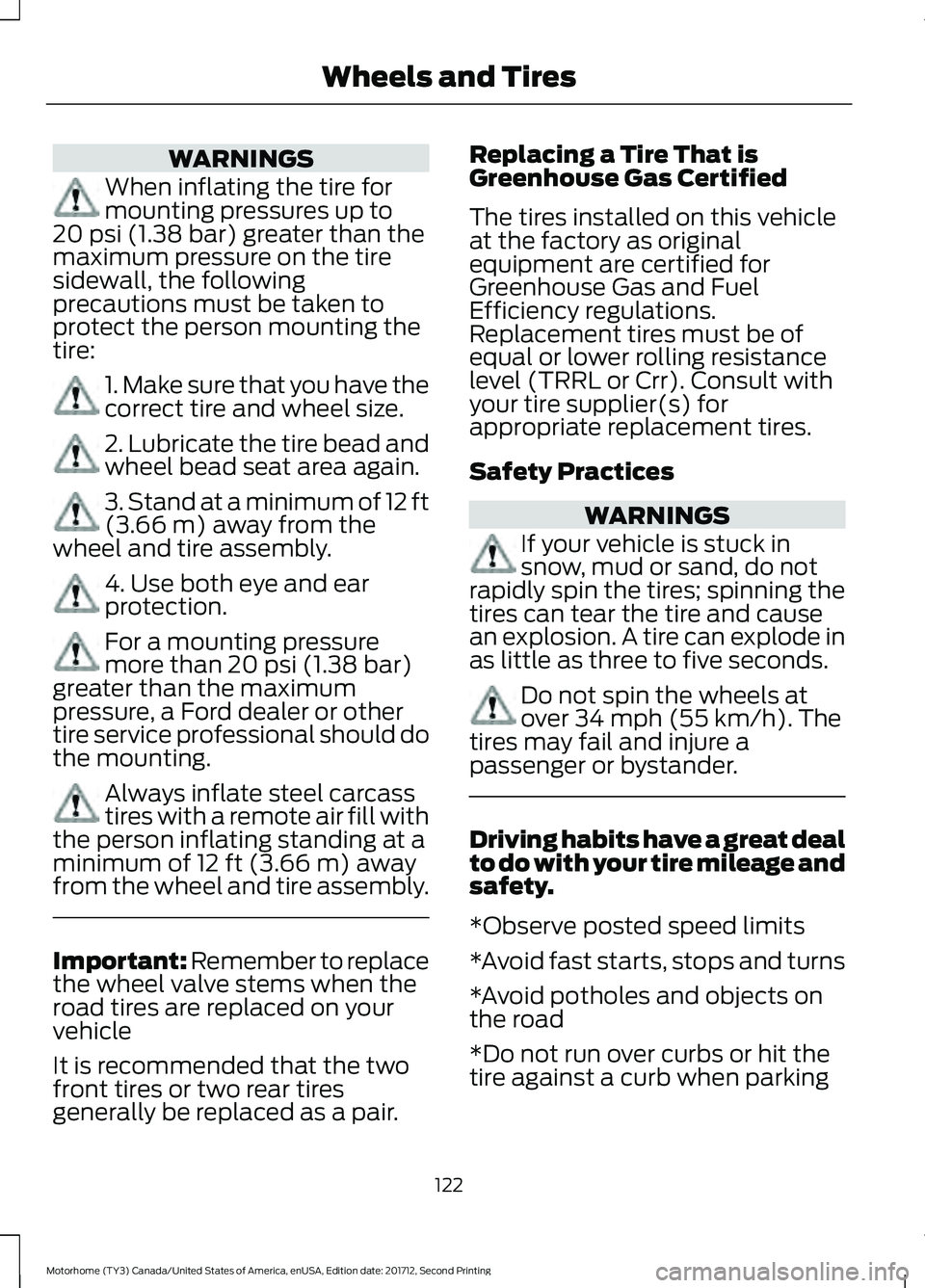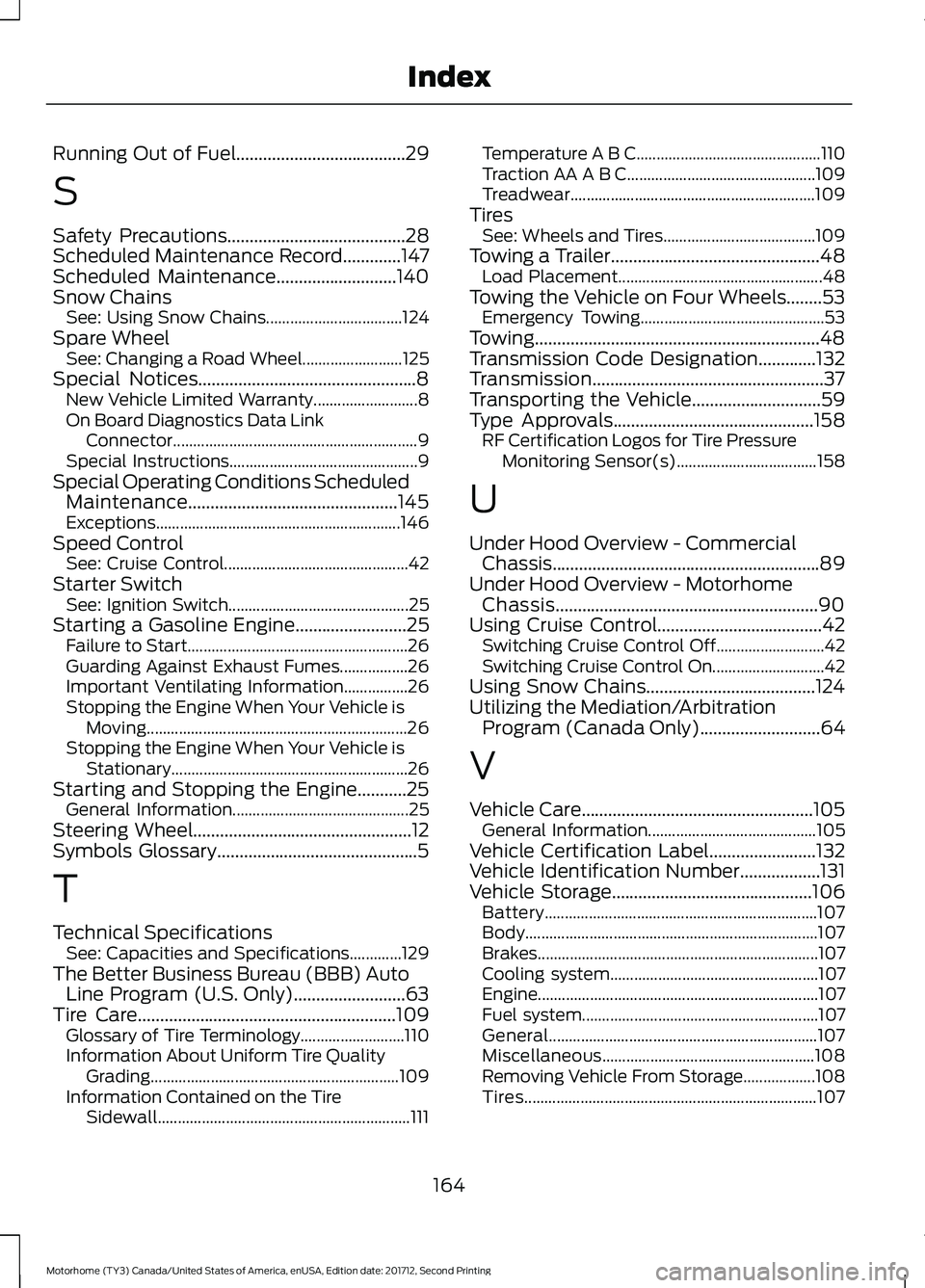stop start FORD F-53 2018 User Guide
[x] Cancel search | Manufacturer: FORD, Model Year: 2018, Model line: F-53, Model: FORD F-53 2018Pages: 168, PDF Size: 3.02 MB
Page 55 of 168

Trailer Brakes
WARNING
Do not connect a trailer's hydraulic
brake system directly to your
vehicle's brake system. Your vehicle
may not have enough braking power and
your chances of having a collision greatly
increase. Electric brakes and manual, automatic or
surge-type trailer brakes are safe if you
install them properly and adjust them to
the manufacturer's specifications. The
trailer brakes must meet local and federal
regulations.
The rating for the tow vehicle's braking
system operation is at the gross vehicle
weight rating, not the gross combined
weight rating.
Separate functioning brake systems
are required for safe control of towed
vehicles and trailers weighing more
than 1500 pounds (680 kilograms)
when loaded.
Trailer Lamps
WARNING
Never connect any trailer lamp wiring
to the vehicle's tail lamp wiring; this
may damage the electrical system
resulting in fire. Contact your authorized
dealer as soon as possible for assistance
in proper trailer tow wiring installation.
Additional electrical equipment may be
required. Trailer lamps are required on most towed
vehicles. Make sure all running lights, brake
lights, direction indicators and hazard lights
are working. Before Towing a Trailer
Practice turning, stopping and backing up
to get the feel of your vehicle-trailer
combination before starting on a trip.
When turning, make wider turns so the
trailer wheels clear curbs and other
obstacles.
When Towing a Trailer
•
Do not drive faster than 70 mph
(113 km/h) during the first 500 mi
(800 km).
• Do not make full-throttle starts.
• Check your hitch, electrical connections
and trailer wheel lug nuts thoroughly
after you have traveled 50 mi (80 km).
• When stopped in congested or heavy
traffic during hot weather, place the
gearshift in park (P) to aid engine and
transmission cooling and to help air
conditioning performance.
• Switch off the speed control with
heavy loads or in hilly terrain. The
speed control may turn off
automatically when you are towing on
long, steep grades.
• Shift to a lower gear when driving down
a long or steep hill. Do not apply the
brakes continuously, as they may
overheat and become less effective.
• If your transmission is equipped with a
Grade Assist or Tow/Haul feature, use
this feature when towing. This provides
engine braking and helps eliminate
excessive transmission shifting for
optimum fuel economy and
transmission cooling.
• Allow more distance for stopping with
a trailer attached. Anticipate stops and
brake gradually.
• Avoid parking on a grade. However, if
you must park on a grade:
1. Turn the steering wheel to point your vehicle tires away from traffic flow.
52
Motorhome (TY3) Canada/United States of America, enUSA, Edition date: 201712, Second Printing Towing
Page 106 of 168

•
The transmission must relearn its
adaptive strategy. As a result of this,
the transmission may shift firmly. This
operation is considered normal and will
not affect function or durability of the
transmission. Over time the adaptive
learning process will fully update
transmission operation to its optimum
shift feel.
• The clock and the preset radio stations
must be reset once the battery is
reconnected.
• Your vehicle ’s engine is electronically
controlled by a computer, some control
conditions are maintained by power
from the battery, the engine must
relearn its idle and fuel trim strategy.
When the battery is disconnected or a new
battery is installed, begin the battery
relearn process:
1. With the vehicle at a complete stop, set the parking brake.
2. Put the gearshift lever in P (Park), turn
off all accessories and start the engine.
3. Run the engine until it reaches normal operating temperature.
4. Allow the engine to idle for at least one
minute.
5. Turn the A/C on and allow the engine to idle for at least one minute.
6. Drive the vehicle to complete the relearning process.
•The vehicle may need to be driven
to relearn the idle and fuel trim
strategy. CHANGING THE ENGINE AIR
FILTER WARNING
To reduce the risk of vehicle damage
and personal burn injuries, do not
start your engine with the air cleaner
removed and do not remove it while the
engine is running. Change the air filter element at the proper
interval. See Scheduled Maintenance
(page 140).
When changing the air filter element, use
only the air filter element listed. See
Capacities and Specifications
(page
129).
Note: Failure to use the correct air filter
element may result in severe engine
damage. The customer warranty may be
void for any damage to the engine if the
correct air filter element is not used. 1. Loosen the latches that secure the air
filter cover in place.
2. Carefully separate the two halves of the air filter housing.
3. Remove the air filter element from the
housing.
4. Wipe any dirt or debris from the air filter
housing and cover.
103
Motorhome (TY3) Canada/United States of America, enUSA, Edition date: 201712, Second Printing MaintenanceE161559
Page 125 of 168

WARNINGS
When inflating the tire for
mounting pressures up to
20 psi (1.38 bar) greater than the
maximum pressure on the tire
sidewall, the following
precautions must be taken to
protect the person mounting the
tire: 1. Make sure that you have the
correct tire and wheel size.
2. Lubricate the tire bead and
wheel bead seat area again.
3. Stand at a minimum of 12 ft
(3.66 m)
away from the
wheel and tire assembly. 4. Use both eye and ear
protection.
For a mounting pressure
more than
20 psi (1.38 bar)
greater than the maximum
pressure, a Ford dealer or other
tire service professional should do
the mounting. Always inflate steel carcass
tires with a remote air fill with
the person inflating standing at a
minimum of
12 ft (3.66 m) away
from the wheel and tire assembly. Important: Remember to replace
the wheel valve stems when the
road tires are replaced on your
vehicle
It is recommended that the two
front tires or two rear tires
generally be replaced as a pair. Replacing a Tire That is
Greenhouse Gas Certified
The tires installed on this vehicle
at the factory as original
equipment are certified for
Greenhouse Gas and Fuel
Efficiency regulations.
Replacement tires must be of
equal or lower rolling resistance
level (TRRL or Crr). Consult with
your tire supplier(s) for
appropriate replacement tires.
Safety Practices
WARNINGS
If your vehicle is stuck in
snow, mud or sand, do not
rapidly spin the tires; spinning the
tires can tear the tire and cause
an explosion. A tire can explode in
as little as three to five seconds. Do not spin the wheels at
over
34 mph (55 km/h). The
tires may fail and injure a
passenger or bystander. Driving habits have a great deal
to do with your tire mileage and
safety.
*Observe posted speed limits
*Avoid fast starts, stops and turns
*Avoid potholes and objects on
the road
*Do not run over curbs or hit the
tire against a curb when parking
122
Motorhome (TY3) Canada/United States of America, enUSA, Edition date: 201712, Second Printing Wheels and Tires
Page 167 of 168

Running Out of Fuel......................................29
S
Safety Precautions........................................28
Scheduled Maintenance Record.............147
Scheduled Maintenance...........................140
Snow Chains See: Using Snow Chains.................................. 124
Spare Wheel See: Changing a Road Wheel......................... 125
Special Notices.................................................8 New Vehicle Limited Warranty.......................... 8
On Board Diagnostics Data Link Connector............................................................. 9
Special Instructions............................................... 9
Special Operating Conditions Scheduled Maintenance...............................................145
Exceptions............................................................. 146
Speed Control See: Cruise Control.............................................. 42
Starter Switch See: Ignition Switch............................................. 25
Starting a Gasoline Engine
.........................25
Failure to Start....................................................... 26
Guarding Against Exhaust Fumes.................26
Important Ventilating Information................26
Stopping the Engine When Your Vehicle is Moving................................................................. 26
Stopping the Engine When Your Vehicle is Stationary........................................................... 26
Starting and Stopping the Engine...........25 General Information............................................ 25
Steering Wheel.................................................12
Symbols Glossary.............................................5
T
Technical Specifications See: Capacities and Specifications.............129
The Better Business Bureau (BBB) Auto Line Program (U.S. Only).........................63
Tire Care
..........................................................109
Glossary of Tire Terminology.......................... 110
Information About Uniform Tire Quality Grading.............................................................. 109
Information Contained on the Tire Sidewall............................................................... 111Temperature A B C..............................................
110
Traction AA A B C............................................... 109
Treadwear............................................................. 109
Tires See: Wheels and Tires...................................... 109
Towing a Trailer...............................................48 Load Placement................................................... 48
Towing the Vehicle on Four Wheels........53 Emergency Towing.............................................. 53
Towing................................................................48
Transmission Code Designation.............132
Transmission....................................................37
Transporting the Vehicle.............................59
Type Approvals
.............................................158
RF Certification Logos for Tire Pressure
Monitoring Sensor(s)................................... 158
U
Under Hood Overview - Commercial Chassis............................................................89
Under Hood Overview - Motorhome Chassis...........................................................90
Using Cruise Control.....................................42 Switching Cruise Control Off........................... 42
Switching Cruise Control On............................ 42
Using Snow Chains......................................124
Utilizing the Mediation/Arbitration Program (Canada Only)
...........................64
V
Vehicle Care....................................................105 General Information.......................................... 105
Vehicle Certification Label........................132
Vehicle Identification Number..................131
Vehicle Storage
.............................................106
Battery.................................................................... 107
Body........................................................................\
. 107
Brakes...................................................................... 107
Cooling system.................................................... 107
Engine...................................................................... 107
Fuel system........................................................... 107
General................................................................... 107
Miscellaneous..................................................... 108
Removing Vehicle From Storage.................. 108
Tires........................................................................\
. 107
164
Motorhome (TY3) Canada/United States of America, enUSA, Edition date: 201712, Second Printing Index